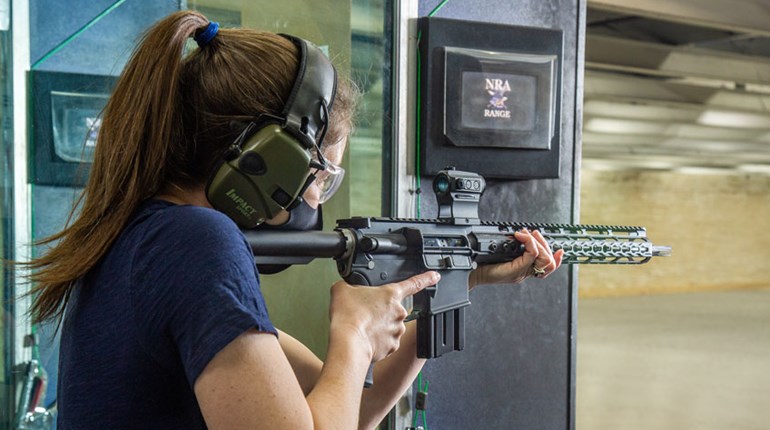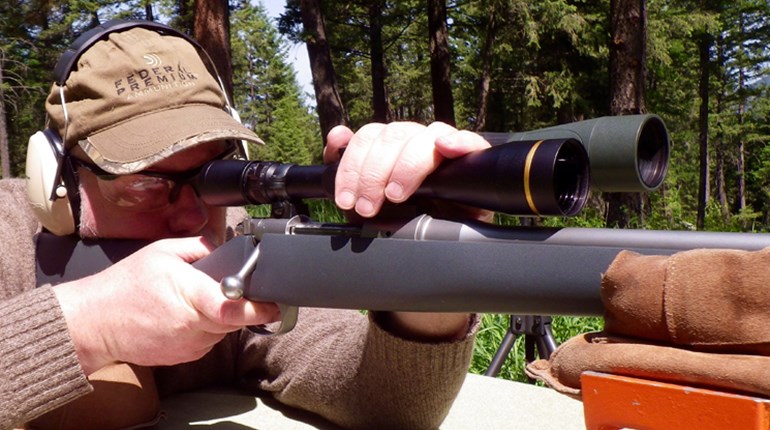
Savage’s new 5-and-a-half-pound sporter isn’t another full-sized rifle with a stumpy barrel. For the first time the company has shaved ounces from its flagship M110 double-lug bolt-action by trimming excess steel from its action and bolt. Like most bolt-actions built in the early to mid-20th century, the Savage is thicker and heavier than necessary for safety and performance, especially with today’s superior steels. While a few manufacturers like New Ultra Light Arms and Kimber started from scratch with trimmed down actions, old school makers like Winchester, Weatherby, Remington and Savage have stuck with their tried and true older actions. Lightening them usually involves shortening and turning down barrels and stocks or building stocks of fiberglass. Some firms replace steel floorplates with ones made of aluminum or plastic, or go to blind magazines.
In the M11 Savage has shaved stock weight by not only trimming dimensions but also milling “ventilation holes” in the fore-end. They slimmed the barrel and cut it back to 20 inches. But their new trick is to mill excess steel from the action walls and bolt. The look is different, distinctive, but not garish. In fact, the tastefully done trimming maintains a visual balance with the smaller stock and barrel. Additional visual “lightening” comes from minimizing and smoothing the barrel lock nut. Its wrench grooves are gone. The large bolt release lever typical of old Savage bolt-actions has been moved to the front of the trigger guard where you hardly notice it. All told, the new look is indeed trim and light.
While the M11 Lightweight is offered in short and long actions, the sample production rifle reviewed here was chambered for the new 6.5 Creedmoor, a Hornady creation that pushes a 140-grain A-Max 2725 fps through the M11’s 20-inch, button-rifled barrel (chronographed 15 feet from the muzzle). While short of 6.5-284 Norma speed, the Creedmoor retains sufficient velocity and energy to remain a viable deer slayer to ranges farther than most of us should shoot. To me its recoil felt like shooting a .243 Win. Handling is quick and slick, too.
I found the bolt throw rougher than that of a typical, full-body Savage bolt. The somewhat rough, satin finish of the barreled action, in this case along the action raceways, slowed bolt travel. The edges of the spiral-fluted bolt body also dragged over the top of the next cartridge in the magazine.
But more important than the feel of the bolt was that after shooting quick rounds in succession I recovered from recoil and got back on target quickly to take out three balloons in 11 seconds. This speaks to the natural pointability of the rifle and its recoil mitigation properties. Just 43 grains of Winchester 760 or Hodgdon Hybrid 100V are sufficient to generate 2725 fps with 140-grain projectiles, a testament to the cartridge. That’s more than sufficient for mule deer, and, with the right bullet, adequate for elk.
A hunting rifle has to be accurate to be effective. This M11 is. From the bench it clustered three Hornady 140-grain A-Max factory loads near a half-inch. Seven three-shot groups averaged right at MOA.
That’s impressive accuracy from a true lightweight, and here’s how Savage gets it: It begins with its proven M110 action using a floating bolt head, which reportedly aligns perfectly with the axis of the bore. Second, that infamous barrel lock nut snugs down perfect headspace. Third, Savage’s button-rifled barrels are famous for consistency. Fourth, the 20-inch barrel, although it is tapered to just .557 inch at the muzzle, is free-floating. Fifth, the AccuTrigger can be adjusted as light as 1.5 pounds pull, yet remains perfectly safe. (The AccuRelease lever inset in the trigger shoe must be pressed all the way back to the actual trigger before the sear can release the striker. Jar the trigger loose and the AccuRelease blocks the striker from hitting the pin.)
The M110 action has never been known for its trim, lightweight elegance. In this M11 version, Savage engineers retained the important stuff for safety and function while milling away superfluous steel. Savage’s dual front gas baffles and big rear bolt shroud remain to block any jetting gases from a ruptured case. Gas ports are drilled on each side of the front receiver ring, and there is plenty of gap around the bolt body for gases to escape upward.
The classic stock is American walnut, but weighs just 1 pound, 12 ounces on our sample rifle. This will vary by wood density, but it’s pretty light. I’ve weighed plenty of synthetic stocks heavier than this. Since the barrel is floated, the channel has been routered out deeper than usual, though a lip is left near the tip to prevent a huge gap from showing.
A final bit of weight is saved by eschewing a traditional hinged floorplate. The M11 wears a detachable magazine with staggered storage but straight-line feeding. A polymer bottom clips into a polymer frame held in place by the action screws. The entire magazine weighs just 2.6 ounces, yet holds four rounds.
In the final analysis, I find this short-action M11 Lightweight in 6.5mm Creedmoor smartly engineered, well built, quick, accurate and a delight to carry. It should make one heck of an enjoyable hunting tool.
Specs:
Type: bolt-action rifle
Caliber: 6.5 Creedmoor
Barrel: length; 20"; button rifled, 1:8" twist
Trigger: adjustable (1.5-6 lbs.) AccuTrigger
Sights: drilled and tapped for scope
Safety: tang-mounted, 3-position
Metal Finish: matte blued
Accessories: swivel studs
MSRP: $875





































